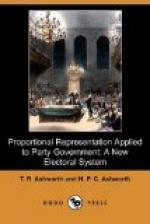Belgium has also quite recently adopted a scheme of proportional representation. As in Switzerland, its advent was hastened by political disturbances. The Catholic party, not satisfied with exerting a preponderating influence in the country districts, wished to obtain also its proportionate share of representation in the cities, and proposed a scheme of proportional representation for them only. This caused such ill feeling that riots took place in the streets of Brussels. Finally, proportional representation was promised all round, and became law for both the Chamber of Representatives and the Senate at the latter end of 1899. In Brussels, where there are 18 seats to be filled, a trial election had already been held in 1893 with satisfactory results. Six lists were nominated, the largest being that of the Socialists, who nominated ten candidates; and over 12,000 electors voted. Each elector was allowed 18 votes, and the methods in which he could distribute them were somewhat complicated. He might (1) mark at the head of a list, (2) mark at the head of a list and also opposite one or more candidates on the same list, (3) mark opposite the names of not more than 18 candidates on any list. In the first case his 18 votes counted to the list marked, in the second case one vote was counted to each of the individual candidates marked and the balance counted for the list; in the third case one vote was counted to each candidate marked. The aggregate of votes marked at the head of each list, plus the individual votes on the list, was then taken as the basis of proportional distribution. So many of the votes were cumulated on lists that only about one-fifth of the votes cast were operative in the selection of candidates.
In the bill which has recently become law a new method has therefore been adopted, which gives more power to the party committees, but allows the electors to modify their choice. For this purpose the party organization nominates the candidates in order of preference. The elector may then accept this order by marking at the head of the list, or he may give his vote to any one candidate on the list. If all the electors of a party vote in the first way, those nominated highest on the list, to the number to which the party becomes entitled, are elected. But if all the electors vote in the second way, those with the highest single votes are elected. The actual result will usually be a compromise between the two, and it is evidently the interest of the party organization to place the candidates in their real order of favour, in order that the electors may accept the list. For if an unpopular candidate were placed at the head of the list few would accept it.
The first election under this system has just taken place, and the result was, as expected, to reduce the Clerical representation considerably.
In all the above variations of the Free List system the distribution of seats is effected by dividing the aggregate votes polled by each party by a unit of representation, but three different methods of determining this unit are in use. The first is obtained by simply dividing the total number of votes by the number of seats.




